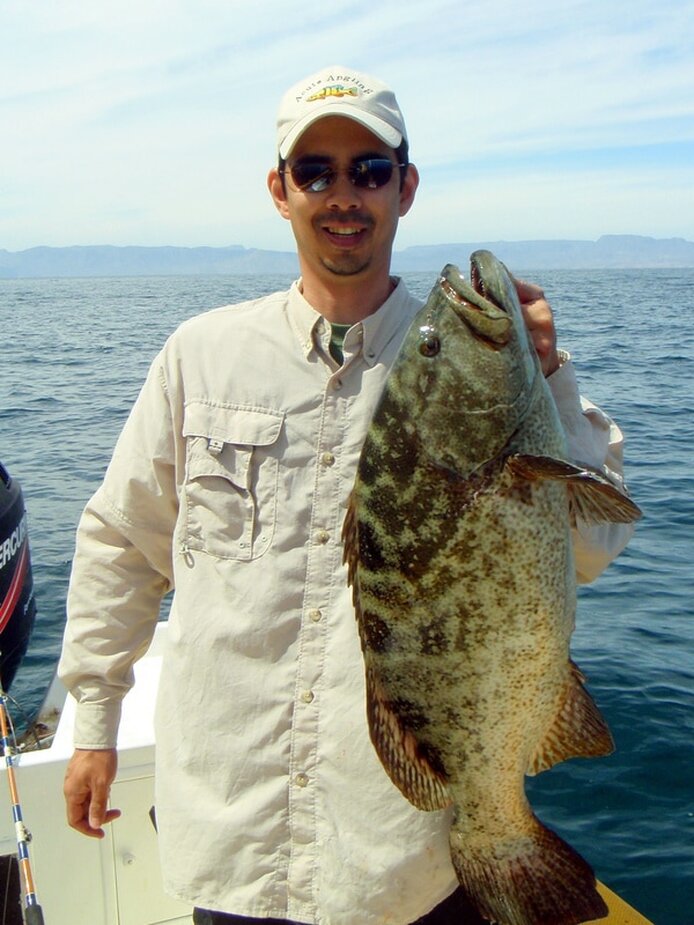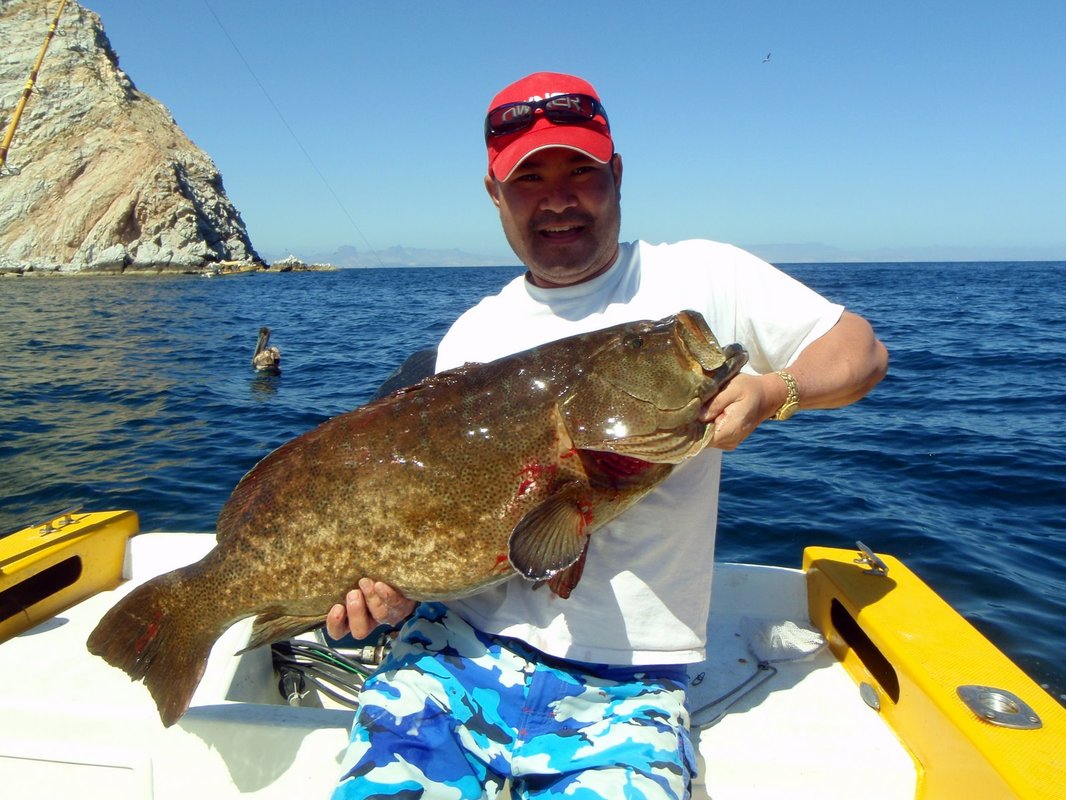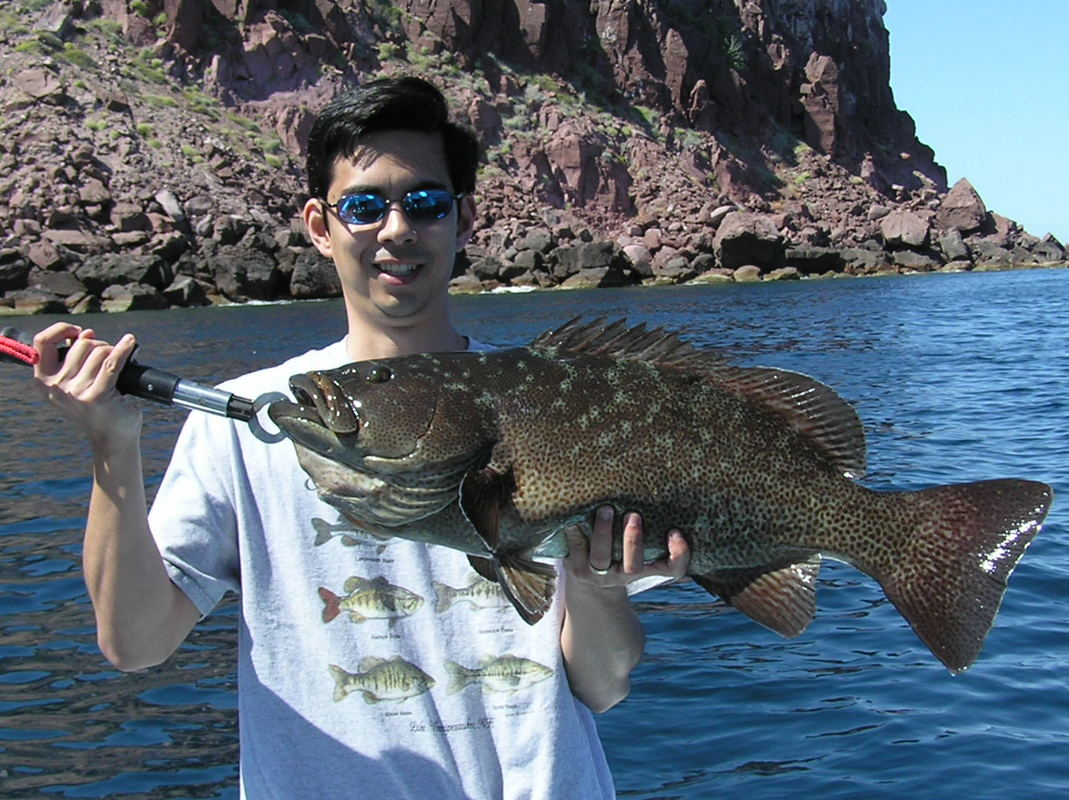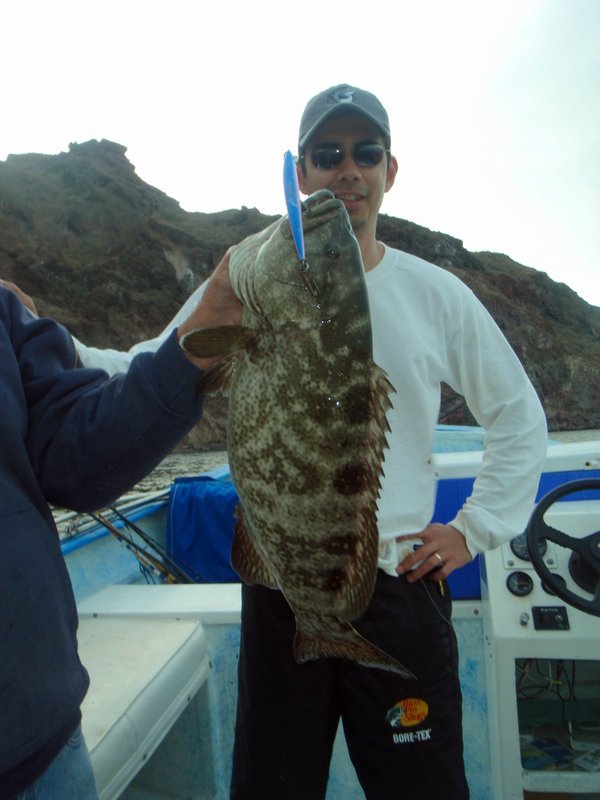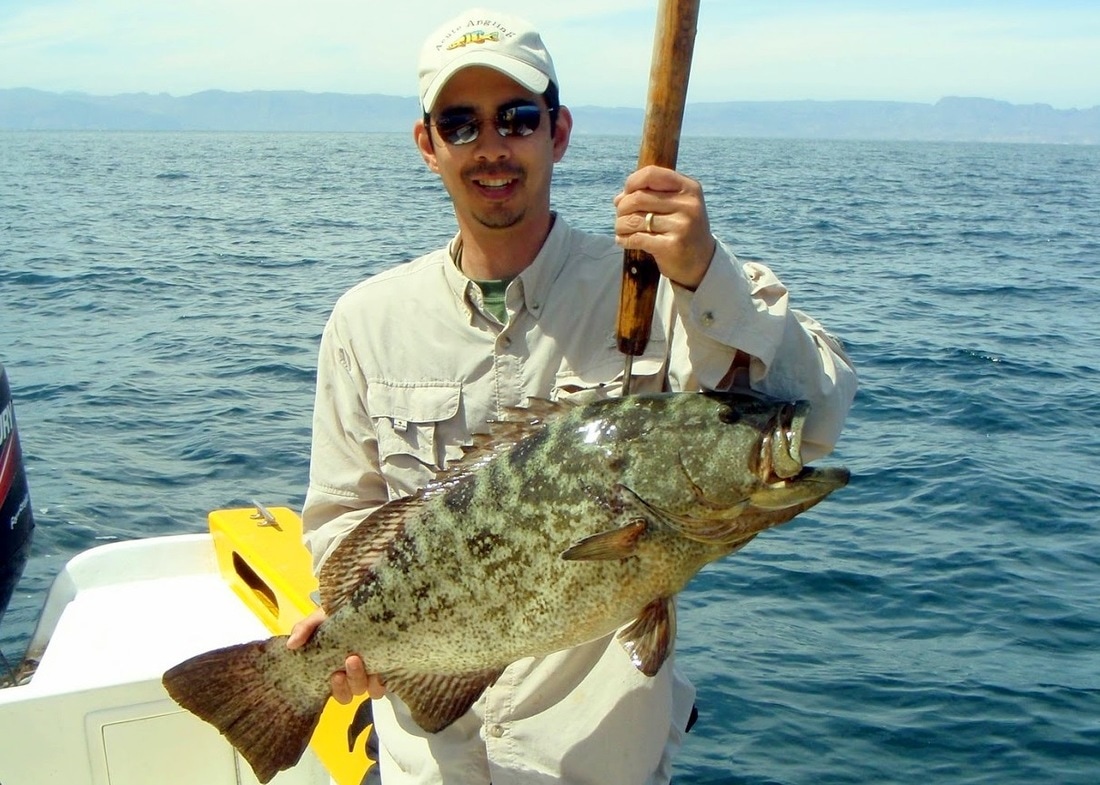Leopard Grouper
Mycteroperca rosacea
Other Species
Home
Leopard Grouper Description
Leopard Grouper are a powerful nearshore predatory fish that are a blast to catch and good to eat. Unfortunately, their numbers have decreased drastically as a result. They generally live in rocky areas nearshore in the Sea of Cortez and the Pacific Coast of Mexico. In Mexico they are referred to as Cabrilla, along with a host of other species of groupers. They generally live in reefs and, when hooked, will make a powerful run to their favorite hole and break you off on the rocks if they can just like most Grouper. They don’t have a lot of stamina, but that initial surge can permanently embed the butt of the rod deep in your gut if you aren’t paying attention. For this reason, even relatively small Grouper often require fairly heavy tackle because of the amount of drag necessary to keep them from their reef.
Leopard Grouper are usually olive or brown as shown in the pictures on this page. However, a tiny number of them become a bright orange for reasons that I do not know. Catching one of these beautiful fish is considered good luck (and it certainly takes a lot of luck to get one), and even some of the most jaded commercial fishermen have been known to throw these fish back despite their tasty meat. I had one hooked and unfortunately lost him, which ranks as one of my most devastating losses.
As mentioned, these fish are tasty, but please consider enjoying their strong fight and then throwing them back so that there will be some left for generations to come.
Leopard Grouper Pound for Pound Fight Rating - 8 out of 10 on the Saltwater Scale
Leopard Groupers, like most groupers, make a mad dash for their rocky homes when hooked. That initial run is very powerful, and you need to do everything you can to keep them from getting to the rocks and breaking you off. I have seen some 8lb Leopard Groupers break people off using 40lb line. They are really tough for their size. Once you get them away from the rocks your chances of landing them get very good, but that first run is very dicey.
Leopard Grouper Culinary Rating - High
They are slow growing and not super numerous, so I generally release them. However, I have eaten one or two and they were delicious just like all groupers.
Leopard Grouper Tackle
This is not a light tackle fish unless you are going for baby ones. Braided line is a big advantage because of its no-stretch qualities. A reel with a quality drag that has a lot of stopping power is a must. If you are fishing in a shallow reef area you may not be able to give the fish any line at all. If you are fishing with monofilament line even if you don’t give any line the line stretch may be enough to allow the Leopard Grouper to get into the rocks. I would fish 65b braid with no less than a 40b leader on a heavy action rod.
Grouper Techniques
Grouper can be caught on lures, live bait, and dead bait. My favorite way to catch them if they are shallow is casting jerk baits and surface irons in shallow reef areas but a large livebait cast towards their rocky lairs is hard to beat. These fish can often be chummed up which gets them a little farther away from the rocks and increases your chances of landing them. When you get a bite, you cannot give these fish any chance to get back to the rocks. Pull hard and don't stop until they are in the boat.
Leopard Grouper Lures
Many people have success trolling deep diving plugs so that they go just above the reef where the fish are. If you are fishing a shallower reef it can be great fun to cast jerkbaits like a Yo-Zuri Crystal Minnow and retrieving them erratically with frequent pauses. Many times the fish bite on the pause.
Surface iron lures similar to those used for California Yellowtail work very well. See the Yellowtail page for examples. You just swim them over the rocks at a steady moderate speed and hang on. The nice thing about hooking them on the surface is that they are farther away from the rocks. Don't get complacent though; you have to pull very hard right from the start to land these.
You can also troll deep diving plugs such as the Mirrolure in Pink or Orange, colors that work surprisingly well.
Leopard Grouper Baits
The best bait for most Grouper is a live fish of some sort. Whatever large baitfish are prevalent in the area should work. If it is legal where you are fishing you can just hook a smaller reef fish of whatever sort is biting, put a big hook in it, and drop it back down. Grouper also like crustaceans such as shrimp and many will eat squid. They are not all that picky, as their large mouths would suggest.
Where to get the big Leopard Grouper
Baja is the place to find these. You need to get away from the heavily populated and fished areas to find ones that have been left alone enough to get to a decent size.
Other Leopard Grouper Resources
The Baja Catch by Neil Kelly and Gene Kira is an excellent resource both on how to catch these fish and where to find them in Baja.
Mycteroperca rosacea
Other Species
Home
Leopard Grouper Description
Leopard Grouper are a powerful nearshore predatory fish that are a blast to catch and good to eat. Unfortunately, their numbers have decreased drastically as a result. They generally live in rocky areas nearshore in the Sea of Cortez and the Pacific Coast of Mexico. In Mexico they are referred to as Cabrilla, along with a host of other species of groupers. They generally live in reefs and, when hooked, will make a powerful run to their favorite hole and break you off on the rocks if they can just like most Grouper. They don’t have a lot of stamina, but that initial surge can permanently embed the butt of the rod deep in your gut if you aren’t paying attention. For this reason, even relatively small Grouper often require fairly heavy tackle because of the amount of drag necessary to keep them from their reef.
Leopard Grouper are usually olive or brown as shown in the pictures on this page. However, a tiny number of them become a bright orange for reasons that I do not know. Catching one of these beautiful fish is considered good luck (and it certainly takes a lot of luck to get one), and even some of the most jaded commercial fishermen have been known to throw these fish back despite their tasty meat. I had one hooked and unfortunately lost him, which ranks as one of my most devastating losses.
As mentioned, these fish are tasty, but please consider enjoying their strong fight and then throwing them back so that there will be some left for generations to come.
Leopard Grouper Pound for Pound Fight Rating - 8 out of 10 on the Saltwater Scale
Leopard Groupers, like most groupers, make a mad dash for their rocky homes when hooked. That initial run is very powerful, and you need to do everything you can to keep them from getting to the rocks and breaking you off. I have seen some 8lb Leopard Groupers break people off using 40lb line. They are really tough for their size. Once you get them away from the rocks your chances of landing them get very good, but that first run is very dicey.
Leopard Grouper Culinary Rating - High
They are slow growing and not super numerous, so I generally release them. However, I have eaten one or two and they were delicious just like all groupers.
Leopard Grouper Tackle
This is not a light tackle fish unless you are going for baby ones. Braided line is a big advantage because of its no-stretch qualities. A reel with a quality drag that has a lot of stopping power is a must. If you are fishing in a shallow reef area you may not be able to give the fish any line at all. If you are fishing with monofilament line even if you don’t give any line the line stretch may be enough to allow the Leopard Grouper to get into the rocks. I would fish 65b braid with no less than a 40b leader on a heavy action rod.
Grouper Techniques
Grouper can be caught on lures, live bait, and dead bait. My favorite way to catch them if they are shallow is casting jerk baits and surface irons in shallow reef areas but a large livebait cast towards their rocky lairs is hard to beat. These fish can often be chummed up which gets them a little farther away from the rocks and increases your chances of landing them. When you get a bite, you cannot give these fish any chance to get back to the rocks. Pull hard and don't stop until they are in the boat.
Leopard Grouper Lures
Many people have success trolling deep diving plugs so that they go just above the reef where the fish are. If you are fishing a shallower reef it can be great fun to cast jerkbaits like a Yo-Zuri Crystal Minnow and retrieving them erratically with frequent pauses. Many times the fish bite on the pause.
Surface iron lures similar to those used for California Yellowtail work very well. See the Yellowtail page for examples. You just swim them over the rocks at a steady moderate speed and hang on. The nice thing about hooking them on the surface is that they are farther away from the rocks. Don't get complacent though; you have to pull very hard right from the start to land these.
You can also troll deep diving plugs such as the Mirrolure in Pink or Orange, colors that work surprisingly well.
Leopard Grouper Baits
The best bait for most Grouper is a live fish of some sort. Whatever large baitfish are prevalent in the area should work. If it is legal where you are fishing you can just hook a smaller reef fish of whatever sort is biting, put a big hook in it, and drop it back down. Grouper also like crustaceans such as shrimp and many will eat squid. They are not all that picky, as their large mouths would suggest.
Where to get the big Leopard Grouper
Baja is the place to find these. You need to get away from the heavily populated and fished areas to find ones that have been left alone enough to get to a decent size.
Other Leopard Grouper Resources
The Baja Catch by Neil Kelly and Gene Kira is an excellent resource both on how to catch these fish and where to find them in Baja.
